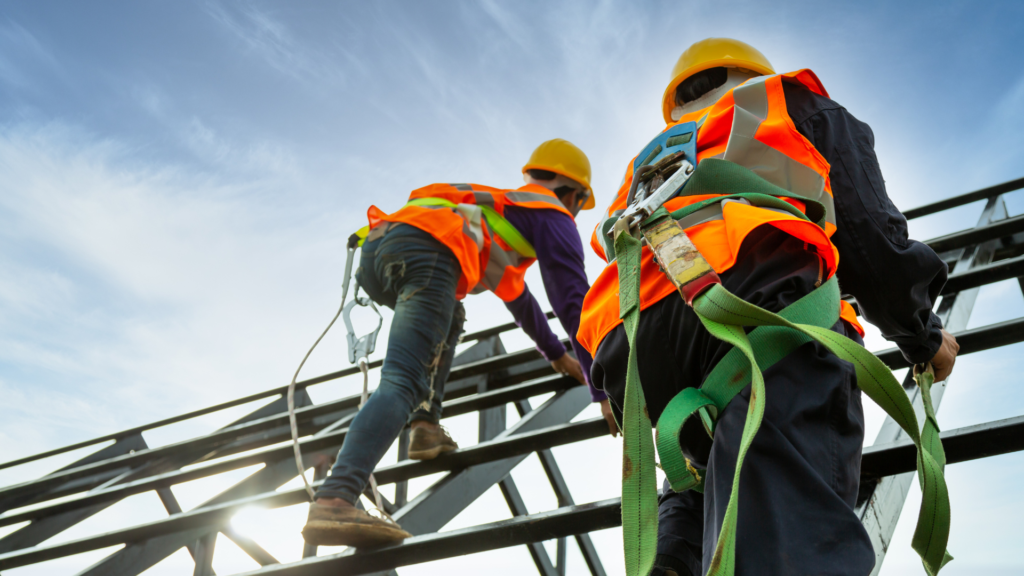Scaffolding is the VIP lounge of the construction world, it lets you work higher, reach farther, and build faster. But here’s the catch: that sleek metal framework can also become a fast pass to the ER if you skip the basics. So before you strut up a scaffold like you’re invincible, let’s talk about what keeps you safe up there, because gravity has no chill.
Your scaffold should be built like it’s holding your reputation, because it is
OSHA doesn’t play around. Scaffolds need to support four times the intended load. That means ditching the duct tape and “good enough” vibes. Use solid-sawn wood, legit planks, and suspension ropes that actually belong on a jobsite, not something you found in the back of your truck.
- Guardrails and Fall Arrest Systems: Going up more than 10 feet? You need protection. Rails or harnesses, no excuses.
- Plank Like a Pro: Platforms should be at least 18 inches wide unless space is tight. Less than that? Add guardrails or fall protection.
- Level the playing field: Muddy ground or sketchy surfaces? Not your friend. Use base plates and mud sills to stay upright.
Golden Rule: If your gut says “that looks sketchy,” trust it. Get a qualified person to inspect before anyone climbs.
If something feels off, it probably is, listen to your instincts
You wouldn’t trust a cracked ladder, so why risk it with a shaky scaffold? A pre-climb check is your first line of defense.
- Declutter the chaos: Keep tools tidy, debris off the platform, and avoid turning your scaffold into a storage unit.
- Watch the weather: Rain, wind, snow? If it feels like a bad idea, it is. Wet platforms are slip-n-slide disasters in disguise.
- Tie It Down: Mobile scaffolds need locked wheels. Suspended ones need secure anchors. Swaying is for hammocks, not work platforms.
Major no-no: Never move a scaffold with people on it. This isn’t a theme park ride.
Falling off a scaffold is one of the top ways workers get seriously hurt or worse. Want to avoid being a stat? Fall protection is the name of the game.
- Guardrails go on every open edge. If there’s no rail, wear a harness with an anchored fall arrest system. Period.
- No leaning, stretching, or Spiderman stunts. Can’t reach it? Reposition the scaffold like a pro.
- Toeboards and warning lines are more than accessories, they stop tools from becoming head-level missiles.
Working near power lines? Pause. Breathe. Measure. Then maybe move back some more.
- Keep 2 feet away from insulated lines under 300 volts.
- Stay at least 10 feet away from uninsulated or higher-voltage lines.
If it’s close, call the utility company. Don’t DIY electrical safety with guesswork.
- Secure your tools. If it’s not clipped, it’s a falling hazard.
- Hard hats are required below. Not for fashion, protection.
- Use netting and debris barriers. Because dropping a wrench isn’t just annoying, it’s dangerous.
Using pump jacks, mast climbers, or mobile scaffolds? Buckle up, these come with bonus rules.
- Pump Jacks: Triangular bracing is not optional. Missing supports are accidents waiting to happen.
- Mast Climbers: Built to handle heavy loads, but only when loaded right. Don’t push your luck.
- Mobile Scaffolds: Lock those wheels and NEVER ride one while it’s moving unless your job title is “bad example.”
Reminder: Not sure it’s safe? Ask a competent person. Assumptions don’t stop injuries.
If your crew is touching a scaffold, they need training. No exceptions, no “learn on the job” nonsense.
- Teach proper scaffold use, not just how to climb, but how to stay safe.
- Spot hazards early, before they turn into headlines.
- Have a plan for emergencies, because winging it isn’t a response.
And inspections? They’re like brushing your teeth, do it daily or deal with the fallout. Especially after bad weather, nearby work, or anything that could shake things up.
If your team is up high, they need more than scaffold skills, they need the Fall Protection & Prevention: Jobsite Safety Training Course. Because nothing ruins productivity like an unexpected plunge.
The Scaffold Safety: Best Practices Training Course gives you the essentials, but there’s always more to learn. Enroll now to level up your safety game. Because in construction, staying alive isn’t just the goal, it’s the bare minimum.
References



